Archives

Cynthia Hopkins
A Living Documentary
FRI JAN 9, 5:00 PM
SAT JAN 10, 8:30 PM
TUES JAN 13, 5:00 PM
WED JAN 14, 8:30 PM
SAT JAN 17, 3:00 PM
SUN JAN 18, 5:00 PM
Run time: 90 minutes
ABRONS ARTS CENTER UNDERGROUND THEATER
466 Grand Street / tickets $20
A Living Documentary is a comedic, no-nonsense reflection on the trials and tribulations of earning a living as a professional theater artist in the 21st century. Intertwining elements of musical comedy, documentary, and fiction, Hopkins’s newest work intersperses autobiographical storytelling with portrayals of semi-fictional comedic characters, all the while asking myriad questions about the realities of artistic life in New York City.
A veritable departure from past works, A Living Documentary presents a stripped-down, one-woman-show, in which Hopkins plays both herself and an eclectic cast of characters. Featuring a number of Hopkins’s original compositions, both live and recorded music will accompany the work.
A Living Documentary was commissioned by New York Live Arts and made possible, in part, by the National Endowment for the Arts (additional support was given by contributors to the Dance Theater Workshop Commissioning Fund at New York Live Arts.) A Living Documentary was developed, in part, through residencies at The Watermill Center (in partnership with New York Live Arts); Bunker in Slovenia (through the Suitcase Fund); Mount Tremper Arts; and Acadia Summer Arts Program. Some material for this work was developed through showings at the Catch performance series.
Photo by Jeff Sugg
Cynthia Hopkins: A Living Documentary at Mount Tremper Summer Arts Festival from Marin Media Lab on Vimeo.
Created (Written & Composed) and Performed by Cynthia Hopkins
Cynthia Hopkins is an internationally acclaimed musical performance artist: she writes and sings songs, records albums, and creates groundbreaking multi-media performance works that intertwine truth and fiction, blurring the lines between edification and entertainment. Through the process of making performances, she attempts to alchemize disturbance into works of intrigue and hope that simultaneously stimulate the senses, provoke emotion, and enliven the mind. She has produced six performance works and eight albums of original music. Her work has been honored with many awards, including the 2007 Alpert Award in Theater and a 2010 Guggenheim Fellowship. Ms. Hopkins also works as a performer and composer for hire, most recently appearing at BAM in the Big Dance Theater piece Alan Smithee Directed This Play. She is currently at work on several new projects (an experimental lecture demonstration about alcoholism; a memorial service for her large-scale works in collaboration with the Fabric Workshop & Museum in Philadelphia; and a piece exploring the trials and tribulations of social media) while continuing to work as a performer, composer, voice over artist, and musician for many other folks. cynthiahopkins.com
“A Living Documentary doesn’t really offer solutions (though it does smartly advocate doing less). But as theater it ultimately offers something more satisfying and complicated: a series of overlapping and sometimes contradictory impulses and desires around the making of art, laced with bracing reminders of the true costs involved in these quixotic pursuits.”
By Claudia La Rocco, The New York Times, Published March 7, 2014
“The story she tells is based on the question she’s been asking herself and fellow artists: What are the best strategies to balance survival with art?”
By Allison Lichter, The Wall Street Journal, Published March 5, 2014
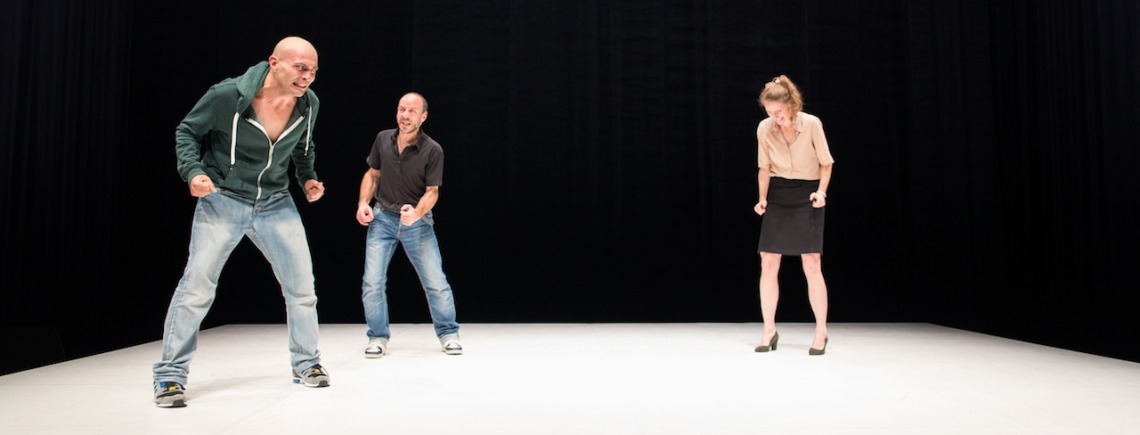
Ivo Dimchev
Fest
North American Premiere
THURS JAN 8, 10:00 PM
FRI JAN 9, 10:00 PM
SUN JAN 11, 10:30 PM
Run time: 60 minutes
ABRONS ARTS CENTER PLAYHOUSE
466 Grand Street / tickets $20
Fest is set in the context of an imaginary festival in Copenhagen. The main characters are the performer Ivo Dimchev, a curator, a technician, and a critic. What starts off as a realistic piece soon turns into a fantasy about sex and power.
“One day I just realized how bored I was with the conventionality of my everyday professional communications. So I thought that breaking this convention by creating a fictional story would be a good way to go. Fest tells the story of my going to a festival in Copenhagen to present my solo Som Faves. The performance explores and makes visible the subconscious connections between power and desire in any professional relations. Fest is absolute fiction and is not based on any real personal experience. Let’s say it’s inspired by some… But mostly it’s inspired by my guilty love for Theatre in its more ‘conventional’ setting.” – Ivo Dimchev
Fest was produced by Humarts Foundation and Volksroom Brussels with co-production support from ImPulsTanz, Vienna; Kaaitheater, Brussels; Frascati, Amsterdam. This production of Fest was supported by fund from the Bundeskanzleramt Österreich.
photo by Danny Willems

idea, text, direction- Ivo Dimchev
performed by- Dolores Hulan, Sandra Wieser, Mirko Feliziani, Ivo Dimchev
light design: Giacomo Gorini
music: Emilian Gatsov
production of Humarts Foundation and Volksroom Brussels
co-produced by Impulstanz Vienna, Kaaitheater Brussels, Frascati Amsterdam
Ivo Dimchev /1976/ is a choreographer and performer from Bulgaria. His work is extreme and colorful mixture of performance art ,dance, theater, music, drawings and photography. Dimchev is author of more then 30 performances. He has received numerous international awards for dance and theater and has presented his work all over Europe , South and North America.
Besides his artistic work Ivo Dimchev gives master classes in the National theater academy/Budapest , the Royal dance conservatorium of Belgium/Antwerp, Hochschule der Künste/Bern, DanceWeb/Vienna etc. He is founder and director of Humarts foundation in Bulgaria and organizes every year a National competition for contemporary choreography.
Since Oct 2009 after doing his master studies on performing arts at Dasarts academy / Amsterdam , Ivo Dimchev moved to Brussels where he opened a performance space Volksroom which weekly presents international young artists.From Jan 2013 Ivo Dimchev is an Artist in Residence in Kaaitheater / Brussels for 4 years. In 2014 Ivo opened his new place MOZEI in Sofia Bulgaria , an independent space focused on contemporary art and music.
“Mr. Dimchev may push taboos in his work, but his timing, his hushed, whispery asides and the two-way conversations uttered under his breath are virtuosic — even reminiscent of Robin Williams. Animalistic one moment, delicate the next, he meshes darkness and lightness with verbal and physical dexterity.”
By Gia Kourlas, The New York Times, Published September 21st, 2014
“The word on the street is that this Ivo Dimchev guy is unpredictable, even dangerous. You just don’t know what will happen when you enter the auditiorium. Mystery and danger, powerful human aphrodisiacs.”
La Vie Viennoise Blog, Published August 5, 2012
“In that work Mr. Dimchev, a Bulgarian artist who lives in Brussels, transformed himself into an aging transsexual, both ethereal and streetwise, to explore sexual and cultural consumption. By the end of the night he drew his own blood into a vial and auctioned it off to the highest bidder. It was fantastic.”
By Gia Kourlas, The New York Times, Published May 1, 2011
“Dimchev masterfully manipulates the truth with the physical metamorphosis of his trickster character; his carriage and execution sew the fabric of the whole together. I felt all the richer for having been played his fool.”
By Lucy M. May, The Dance Current, Published December 3, 2011
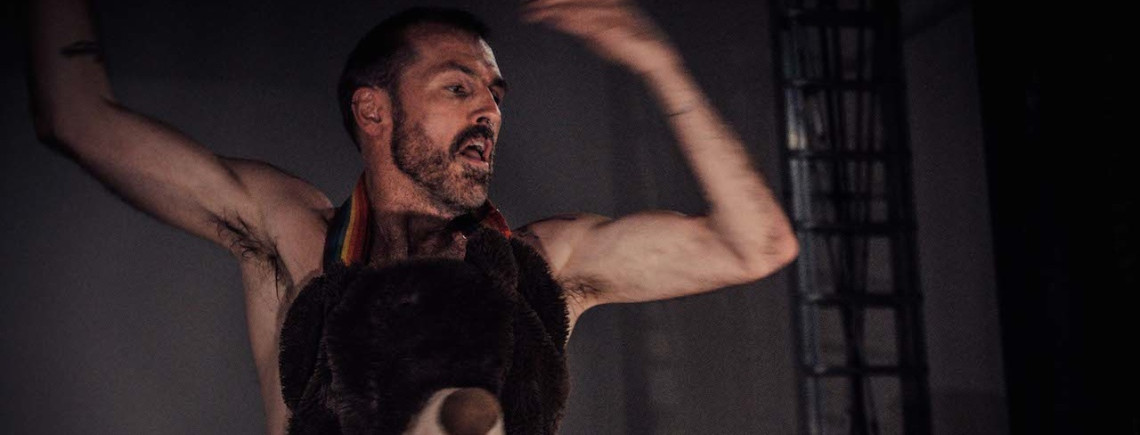
Keith Hennessy
Bear/Skin
World Premiere
THURS JAN 8, 7:00 PM
FRI JAN 9, 8:30 PM
SAT JAN 10, 7:00 PM
SUN JAN 11, 2:30 PM
Run time: 65 minutes
ABRONS ARTS CENTER EXPERIMENTAL THEATER
466 Grand Street / tickets $20
Motivated by grand spectacle and ambitious prayer Bear/Skin appropriates Nijinsky’s choreography for Le Sacre du Printemps (1913) to consider Modernism’s dependence on appropriations of the indigenous, folk, exotic, and oriental to ask questions about ritual and art today.
“There will be a bear dance that has nothing to do with gay bears and everything to do with Rite of Spring, teddy bears, the reconstruction of native/folk bear dances, action movies and virgin sacrifice, springtime in the northern hemisphere, the land I grew up on and where my parents are buried, and the land I now live on where my uncle and many others are buried. But it’s also about dancing and ritual and appropriation; the struggle between being both settler and indigenous, nomad-refugee and precarious freelancer. Don’t expect a lecture or much coherence. Come to heal and be healed or not.” – Keith Hennessy
Bear/Skin is produced by Circo Zero with support from the Zellerbach Family Foundaton and San Francisco Grants for the Arts. Project Management by Alec White. Fiscal Sponsorship by CounterPULSE.
Image by Robbie Sweeny.
Bear/Skin Preview 2014 from Zero Performance/Keith Hennessy on Vimeo.
Bear/Skin (Market Street 9.14) from Zero Performance/Keith Hennessy on Vimeo.
Fake Healing SF, Sep 2014, Bear/Skin from Zero Performance/Keith Hennessy on Vimeo.
Choreography, design, performance by Keith Hennessy
Produced by: Circo Zero
Production Management by: Alec White
Fiscal Sponsor: CounterPULSE
$4000 grant from Zellerbach Family Foundation, and a little bit of ongoing support from SF Grants for the Arts.
NYC performances co-produced by Ben Pryor/tbspMGMT, and American Realness Festival.
Thanks to the dancestors, CounterPULSE, Salta & PPP where it all began, American Realness, Gabriel for non-stop stomping, Jesse and Mica for motivating the shaman, Mark McBeth for following me into the street, my studio witnesses Tessa Wills, Margit Galanter, Larry Arrington, Sara Shelton Mann, & to Ian, Ruairí, Alec, Chani, Andres, Julie, my Davis queer critical race posse, SF Grants for the Arts, and you.
Keith Hennessy has been crafting imaginative and critical performance works since the early 80s. These performances have been awarded a USA (Kjenner) Fellowship (2012), a NY Bessie (2009), several Isadora Duncan Awards, a Goldie (2007), and the Alpert/MacDowell Fellowship in Dance (2005). Hennessy was born in Sudbury Canada, a mining town in Northern Ontario. He lives in San Francisco, and works regularly in Europe. He is a Bessie and Izzy award-winning performer, choreographer, teacher and organizer.
Hennessy directs Circo Zero, a laboratory for live performance that plays with genre and expectation. Rooted in dance, Hennessy’s work embodies a unique hybrid of performance art, music, visual and conceptual art, circus, and ritual. Keith has an MFA in Choreography and is a PhD candidate in Performance Studies at UC Davis. He is a highly sought teacher of contemporary dance, performance, and improvisation who teaches extensively in Europe and most recently (20011, 2013) in Senegal. Despite narrowly surviving the last two waves of violent eviction and gentrification, and the forced relocation of way too many of his close colleagues, Hennessy still lives in San Francisco.
“Hennessy is that rare artist who succeeds in translating fierce social concerns into artistically satisfying creations that enlighten and entertain. Against all odds he believes in art’s power to reassume its ritualistic and healing function.”
By Rita Felciano, SF Bay Guardian
“Hennessy is among those artists whose contributions have helped form the size, shape, and feel of art and life in the Bay Area. He’s brutally honest, passionate, sometimes overbearing and worth seeing for all those reasons.”
By J. H. Tompkins, SF Bay Guardian
“Keith Hennessy’s stage presence burns; he ignites any subject he tackles. Sacred, violent, and compassionate impulses shape our everyday lives; it is through a genius like Hennessy, though, that we can confront the state of the human condition.”
By Katia Noyes, SF Weekly
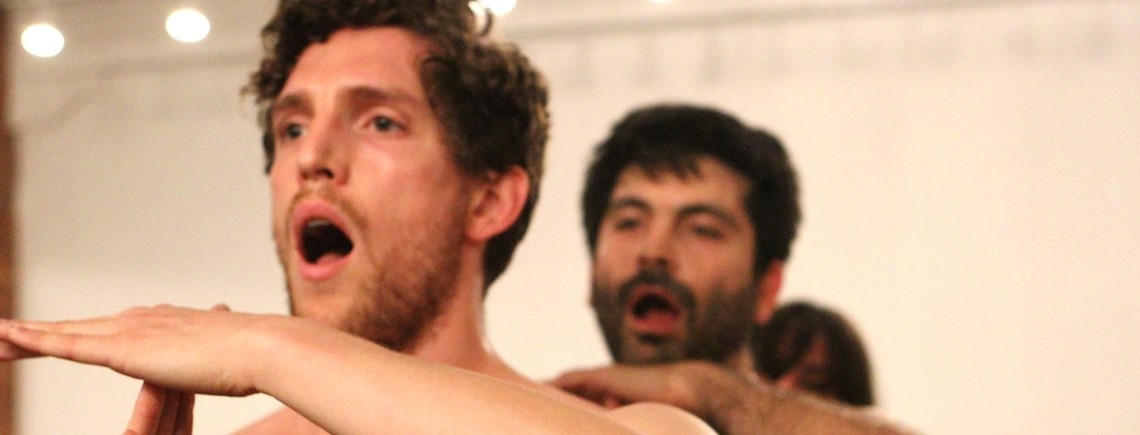
Juliana F. May
Commentary=not thing
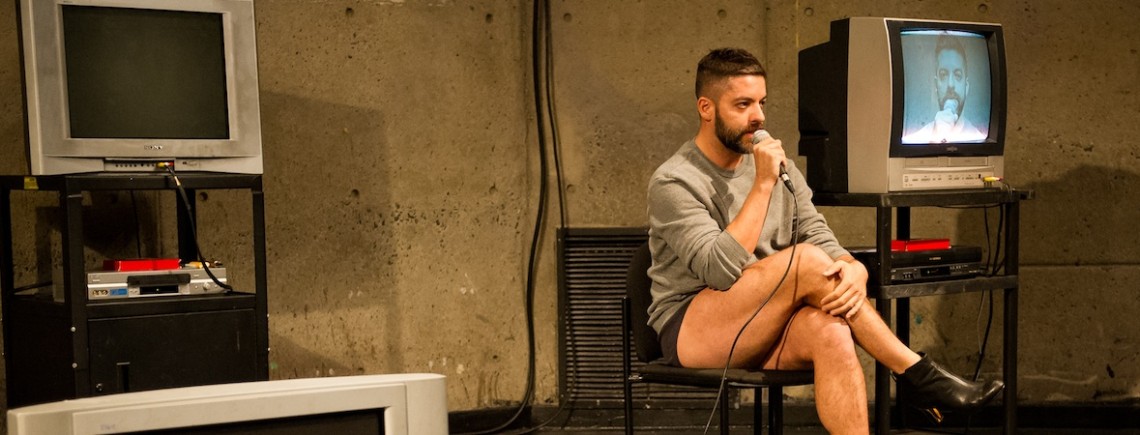
Miguel Gutierrez
myendlesslove

300 Words on Realness: 13 Love Songs: dot dot dot
300 Words on Realness: 13 Love Songs: dot dot dot
by Lydia Mokdessi
Published on: January 19, 2014
13 Love Songs: dot dot dot opens with a smudging and the distribution of chocolates by cheerful undies-clad ushers, cementing the good vibes of Abron’s Underground Theater (“the bunker,” as Houston-Jones has called it). Strewn onstage are yellow roses, a pile of prescription bottles, a ukulele, stuffed animals, and a collection of prayer candles.
30 seconds into song 1 (The Magnetic Fields) Wexler’s singing turns to shrieking while Houston-Jones spews gin out of his mouth. Songs 3 (Cat Power) and 4 (Gin Blossoms) are accompanied by quirky synchronised gestures and a headbanging, lip-synching, teenage bedroom rock out sesh. Wexler shares excerpts of adolescent journal entries documenting an almost decade-long crush, which are sweet / hostile (“it’s the way his soul looks in the moonlight…” “Dear Dave, why are you still alive?!”). Houston-Jones is abandoned with a bandana-covered face; he lunges / collapses with crossed fists and butterfly hands.
She offers a deadpan Ja Rule recitation (“baby say yeah,” he parrots), giving way to a plodding middle-school-talent-show-style duet. They rub their faces with onion halves, sobbing / laughing / wailing. It feels weirdly real, like the reverse of the force-a-smile-and-you’ll-feel-better phenomenon. To melancholic Kate Rusby (song 11) she reappears in a gauzy pink dress for a flingy, lyrical solo, her waist-length hair like 100 extra limbs. The prettiness is precarious — the scene deteriorates. She repeatedly punches herself in the face.
They share poetry by flashlight like sleepaway campers: “Some Reasons Why Your Anus is not like Everest” (his) and “For The Love of Dave Dick” (hers), and he prepares a small shrine of photos (of people they have each loved?) while she guides a meditation on falling in love with oneself and one’s neighbor. We hesitate, but she assures us that it’s a “nice thing,” and she’s right — it’s poignant and genuine.
The emotional arc of 13 Love Songs is complex (likely made more complex with backstory: Houston-Jones sustained a heart attack in early 2013, Wexler became his caretaker, and they agree that their collaboration became more sincere from this point) and it is at turns heartfelt, cynical, joke-y, and dark. We feel for them from the start — even when they’re making fun, the ecstasy / heartbreak that acted as source material peek through.
image: Ian Douglas
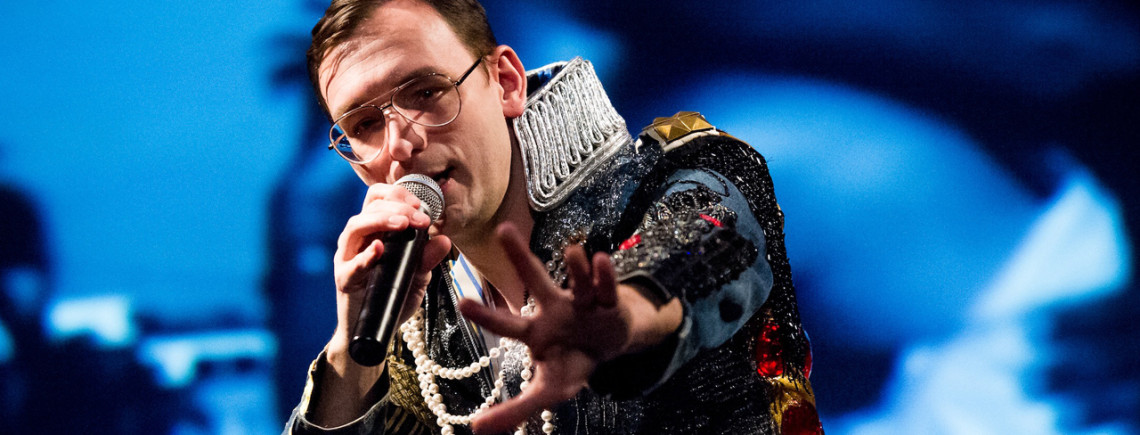
300 Words on Realness: King
300 Words on Realness: King
by Lydia Mokdessi
Published on: January 19, 2014
Neal Medlyn’s King, the seventh of a seven-show series on pop stars / iconic groups (Michael Jackson, this time) is big and brash, with a DIY vibe. It opens with Medlyn’s back to us, the gold patchwork curtain draped on his shoulders and soon drawn back to reveal a choir of four deadpan middle schoolers, backing up his spazzy strutting and echo-heavy singing. Surrounding them is a menagerie of colorful objects, bedazzled jackets, piles of stuffed animals, random shrine-like collections of toys and costume pieces. Distorted videos of Michael Jackson’s face, computer illustrations of a fairytale, and a reel of semi-disturbing images (snakes, skeletons) play behind them.
Medlyn chats and tells fragments of stories as he moves between piano and mic stand like a one-man cabaret show (he likes to think that “we’re just all hanging out in his atrium while he mists his plants.”) The audience engages most fully when his stream-of-consciousness crystallizes into re-thought but still recognizable MJ songs, sometimes delivered in a goofy, nasal, over-annunciation. Stadium concert traditions are acknowledged and subverted, like delivering a song’s climax while standing in front of a small fan instead of a wind machine and trading a confetti cannon crescendo for the pop a tiny confetti tube at the finale.
King is not a tribute (he wears two gloves, after all), but is tangential to the images and feelings we associate with MJ. Buried in the stories and songs are strains of childhood, fantasy, glamour, tenderness / sweetness (“oh sweetness”), universal love, (“what if we touched people just to bless them?”), and worship. There is a religious fervor quality to the work, or the desire to tap into some spiritual or collective energy generated / accessed by mainstream “stars.” King (like the six preceding shows) is concerned with the phenomenon of celebrity and celebrity persona / personhood. What specific collection of attributes makes MJ MJ? How much of what we’re seeing is really Neal? It’s a performance about performance, a big run-on sentence punctuated with nods to the codes and decorum of pop music, and a complicated exploration of someone with an equally complicated identity.
image: Ian Douglas
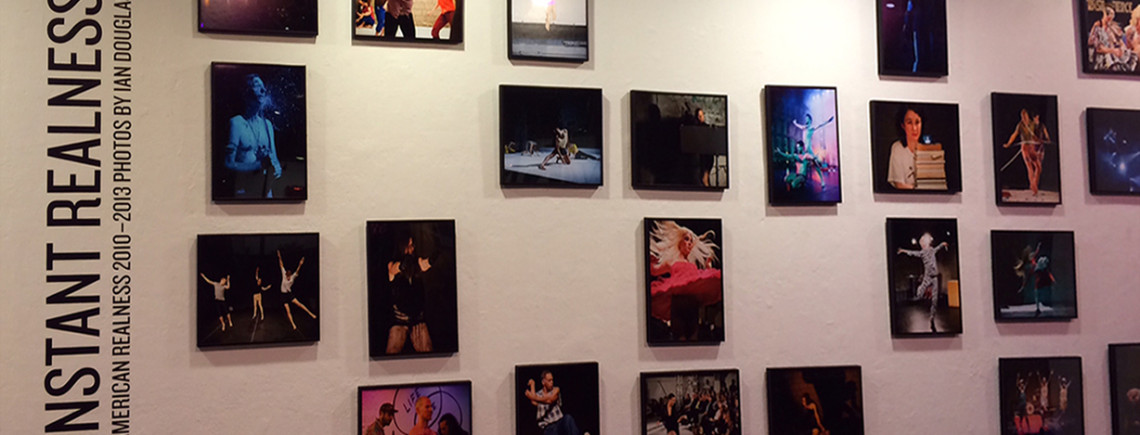
Remembering Performance
Remembering Performance
On The American Realness Exhibitions
by Lauren Grace Bakst
published on: January 18, 2014
It’s 3:48pm on Monday, January 13th and I’m sitting in the American Realness festival’s pop-up cafe at Abrons Arts Center. In front of me are glass windows, through which I can see the edges of the Main Gallery where Ann Liv Young has taken over with the Sherry Art Fair. Young’s daughter Lovey runs up the stairs to help her mom set up. Like Young’s alter-ego Sherry, Lovey goes by Rainbow Dash, and will soon be offering makeovers. The wall behind me displays Instant Realness—a selection of framed photographs by Ian Douglas that document performances from the past five years of the festival. If I walk around the corner and down the stairs, I’ll pass by the Culpeper Gallery where Sarah Maxfield’s audio-installation Nonlinear Lineage: Over/Heard lives. And if I’m waiting for the The Playhouse doors to open, I’ll be in the presence of Fawn Krieger’s nine-foot silver-metallic statue of Neal Medlyn as Michael Jackson.
These exhibitions fill the interstitial spaces of the festival—the hallways and rooms you awkwardly exist in between the show you just saw and the one you’re waiting to see. The conversations here almost always begin in the same way: “What are you seeing?” … “What have you seen?” … “What did you think?” … They veer off into various stutters, questions, and declarations as inevitably we try to articulate our feelings about this complicated form we all love. These in-between spaces are where we hangout and chat, yes, but they’re also where we remember. In conversations with acquaintances or aimlessly meandering through the halls, we form our thoughts about the things we’ve seen. And these new versions of the performances, the ones distorted by memory, become ours. The American Realness exhibitions lend themselves to this reflective space. Each one proposes a distinct mode of remembering performance. The photographs and memorabilia, the collected and constructed artifacts—this is the stuff of performance’s excess. It’s that story you tell over and over. It’s that image you associate with a particular dance. These are the things we hold on to, or try to anyway…
GLOSSY HEROES
For those of us returning to the festival, the artists pictured in Douglas’ Instant Realness will be familiar faces (Miguel Gutierrez, Ishmael Houston-Jones, Eleanor Bauer, etc.). There might even be familiar images, for instance those that have been used in conjunction with promoting a particular performance. Douglas’ image of Gutierrez’s And Lose the Name of Action with Hilary Clark in the foreground comes to mind. Do I remember it because I’ve seen it reproduced in so many places—venue websites, interviews, reviews—or because of its compelling composition? The way it transmits the field of energy created in the performance to an image? Probably both. Douglas, however, does not necessarily intend to preserve the performances he documents in their original feeling or form. While the works themselves are ephemeral, these images are iconic. More often than not, Douglas has caught the performer in the midst of a difficult, exhausting, exposing dance, but damn, in these photos, y’all look good! I mean seriously you look really good. Cut the photo of Ann Liv Young (so you can’t see her vagina) in half and she really could be a Disney© Princess. Douglas’ photos transform his subjects into glossy heroes. Sweat glistens, rather than smells. The framing and light serve to dramatize and memorialize the performers’ fleeting actions. In an economy where representation is value and performance is well … something else, what’s not to love?
INVISIBLE MONUMENTS
On Thursday, January 9th, I went to see Michelle Boulé’s WONDER in the Abrons Playhouse. I waited in line for my ticket, said hi to my friend, rushed to the bathroom, and entered the theater. And somehow I completely missed Fawn Krieger’s towering statue of Neal Medlyn as Michael Jackson. It was there, and I’m sure I saw it, but I didn’t really take time to notice it. That’s the thing about statues though—they’re everywhere. And while they signify importance, they usually also signify absence. (This person died, but here’s a stone figure to help you remember him.) I don’t typically acknowledge the presence of statues in the parks and plazas of New York—they are a normative and implicit element of the city’s architecture, and have the potential therefore to become invisible. But as we all know, Krieger’s sculpture is not your typical statue. It is a figure of someone—Medlyn—embodying someone else—Jackson (who, by the way, has already been the subject of a statue that was erected and subsequently taken down. Google: Michael Jackson statue.) Krieger’s statue exists in conjunction with Medlyn’s show King, the conclusion to his Pop Star Series and ode to Michael Jackson, which he describes as being about “epic attempts.” An attempt implies the potential of failure. An epic attempt practically guarantees it. When Medlyn wholeheartedly steps into the role of a celebrity, he exposes the vulnerable, tragic, and ridiculous nature of being a performer. Similarly, Krieger’s statue is both shiny and awkward. Cheeks bulge and glasses protrude. The surface isn’t smooth—bumps, ripples, and imperfections reveal the imprints of making. Medlyn’s Pop Series might be over, but Krieger’s statue isn’t going anywhere. I imagine that after this festival, it will go live in some basement or closet storage space until its next appearance. It’s my fantasy that by some fate of magic, it will end up in the same storage space as the discarded Michael Jackson statue. And then Neal Medlyn as Michael Jackson and Michael Jackson will stand side by side in some dark corner together.
TINY COLLECTIONS
When I was a student at Hollins, I would watch videos of Ann Liv Young’s dances. I was always enamored by her attention to detail, not just to the performers’ execution of movement and text, but to the entire space—the color palette and textures, the costumes and objects. Watching her work helped me understand the importance of owning your aesthetic. With the Sherry Art Fair, Young extends her careful consideration of aesthetics to her character, Sherry, the unpredictable southern Christian woman who is not afraid to call you out on your bullshit, but ultimately wants to help you live a better life. There are bright pink christmas trees and a pink fountain. Pink tape attaches a sketched portrait of Sherry to an ornate frame. Patterned tablecloths are covered with glittered jewelry. DVDs and t-shirts are for sale. These seemingly haphazard displays create a context for Sherry. They give her credence as a person—these collections make her real, and because they do, we believe her. We might even buy something from her! Simultaneously embracing and satirizing the consumerism that drives the art fair phenomenon, the Sherry Art Fair performs what it is.
HISTORICAL PLEASURES
Reel-to-reel tape recorders with headphones await pairs of ears. Listen, and you’ll hear a carefully curated audio loop of excerpts pulled from interviews Sarah Maxfield has conducted with a range of artists, some familiar to the festival and others not—Jennifer Miller, Ishmael Houston-Jones, Jen Rosenblit, Annie Iobst, Janet D. Clancy, and more. This is Nonlinear Lineage: Over/Heard, created by Maxfield in collaboration with Elliott Jenetopulos, Laurie Berg, Brad Kisicki, and Chloe Z. Brown. Of all the exhibitions, this one deals with remembering performance the most directly. It embraces memory’s flaws, and in doing so celebrates the way we, as participants in this field, carry our experiences of performance with us in our bodies and throughout this city. One moment, I’m listening to Clancy’s account of being backstage during Einstein on the Beach. Then comes in Houston-Jones, who remembers wishing it could go on forever … Later, Houston-Jones’ voice comes back. He remembers watching John Kelly at The Pyramid. Then comes in Kelly. He remembers that time there was a crazy heckler. These interconnected loops keep popping up, and you start to feel the weight of this form we participate in. We watch each other; we are moved by each other; we remember for each other. Collectively, these memories offer an entangled account of what it feels like to be subsumed by dance in New York. Maxfield and her collaborators are not only recording these stories to preserve and document them. Through this compilation, Maxfield is doing what I believe to be the real work of the historian. She is crafting a structure that communicates the feeling of being in a particular time and place. This structure does not pretend to be complete or impartial or singular, rather it is committed to partiality, subjectivity, and multiplicity. Nonlinear Lineage: Over/Heard transmits the feeling of what it is to live this form, and in doing so it remembers performance, and honors the often unquantifiable pleasures that are the rewards of devoting our lives to this field.
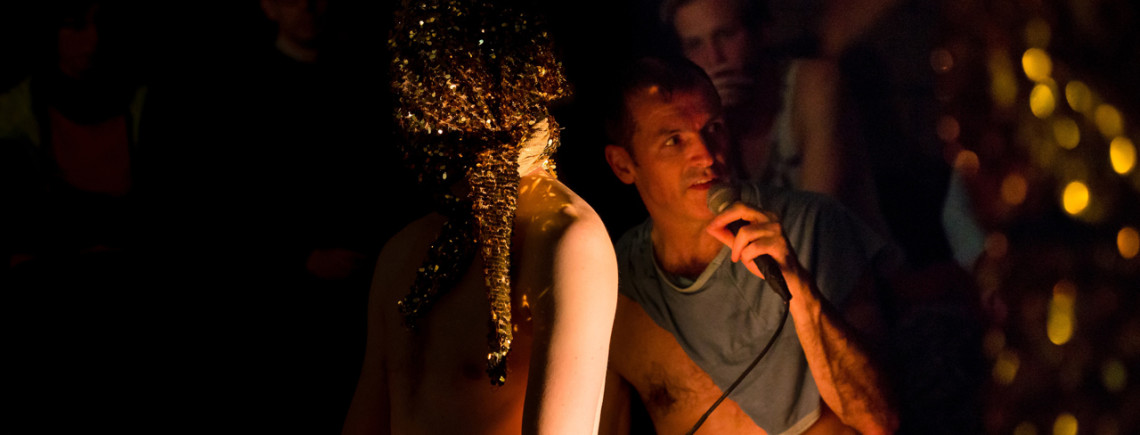
My American Realness
My American Realness
by Keith Hennessy
Published on: January 19 , 2014
I have shown work three times at AR (Crotch 2011, Almost 2012, Turbulence 2013). I can’t remember if Ben P contacted me or I contacted him. Maybe my cousin Miguel Gutierrez was the connective tissue. Usually I’d recall this process because getting gigs is often so arduous and insulting. At AR I felt like a member of a community, however temporal or competitive or unfamiliar, and perhaps only linked as much by our tenacious work as by our tenuous friendships.
AR is unlike any other festival. It’s not a DIY queer thing in San Francisco or Berlin but it’s similar in that it’s too broke to pay artists and yet we still want to perform there. It’s not a booking conference but it is a barnacle on a booking conference, situated within that conference’s temporal and spatial orbit. That’s not quite right… AR is part of the conference’s counter narrative, both feeding off the main body’s excess resources and infusing it with new blood (tactics, models, art, bodies). Most festival’s have jam packed schedules that inspire a lot of running around but AR is spatially dense like a Vegas casino that entices us to never leave the building. Artists, from the festival, from NYC, from a lot of places, are crowded in tight with folks who really want to experience the work live. The art seems important but not precious, as does the audience.
The festival has grown. It now occupies more days and produces more performances than when it began. It made a big jump in visibility and notoriety after the first year or two and by year three the press and many presenters were treating it as a serious showcase of contemporary dance-performance. The omni presence in 2013 of a NYTimes writer with a reputation for being ignorant or hostile to “downtown” dance felt like a coming of age. The festival has also not changed. Many of the same artists are presented and most new artists to the festival are colleagues whose work already circulates in shared contexts. One of the only options for growing the festival is through off-site presentations and co-productions. This is already happening but not at a scale that destabilize’s Abrons as the physical (and metaphoric) heart of AR.
I think that AR has a particular aesthetic or set of aesthetics but I hesitate to name it. The frames and styles are still too vague or still in amniotic fluid so they resist any close attention or definition. A long-time performance viewer can see direct references or quiet traces of several NY lineages including minimalism, Cage/Cunningham, Jack Smith, Ridiculous, WOW, ACT-UP, Klein & Skinner, 80s performance at PS122, and the formalist branches of Judson. Continuing to read NYC performance histories we might say there’s more Wooster than Living, more downtown than Harlem, more Trio A than Grand Union, more academic postmodern than street or club hip hop. Of course recent Euro conceptualism, several phases of Anna Halprin’s influence, contact improvisation, new age ritual, the turn towards theory, contemplative somatic inquiry, and youtube can also be referenced or felt in a single weekend of AR.
I don’t make work for the aesthetic container of AR. Somehow my work, despite its hippy-punk west coast roots, already participates in the aesthetic games and inquiries that links (but does not unite) most of the artists featured at AR. The aesthetic links between AR artists are less important to the curation than a network of social relations: friendships, collaborations, parallel tracks, and shared histories that make us aware of and curious about each other. The core curatorial practice seems pretty basic: Ben has simply followed a very small number of NY-based or formerly NY-based dance artists (resonant with his own curiosities or politics) into a variety of national and international contexts where he can be introduced to a rhizomatic assemblage of artists and performances that might be invited to AR.
APAP, although never designed to hurt people, especially artists, has been called dreadful, a meat market, a waste of money, and irrelevant. The monster truck gathering of (mostly) US presenters has generated cattle call performance factories, called showcases, from which many of the AR artists have fled, if they were even invited. Paying to be “showcased” or “represented” at APAP has done nothing for me, except steal my money. Being presented in AR has been satisfying and empowering. I would do it again if I had to pay for everything, even though I think it’s biggest problem is a lack of money to pay artist fees, travel, and housing. Performing at AR has brought me gigs in major and minor venues in the US and Europe including TBA/Portland, City of Chicago, Kampnagel/Hamburg, Theater der Welt/Mannheim… Equally or perhaps more importantly AR keeps me in contact with artist friends in NYC, and with NY and Euro presenters who are less likely to come further West.
At mid-career (or am I past that?) AR has offered me a kind of spiritual inspiration that I don’t want to poop on by making it seem too deep but I despair easily so this inspiration is crucial to my continuance. Maybe it’s because I feel like I barely have an audience (and that includes funders, audience, presenters) in the US beyond a marginalized scene in SF for which I am almost too old. It’s stupid to talk like this because the past couple of years have been really great for me (gigs, one big grant, one big award) but I’m still begging for $1000 every time I want to do a project. I’ve been rejected for the last two grants I’ve written which then paralyzes me from writing any others for six months to a year. I haven’t had consistent admin help in two years. Right now I’m in the luxurious beauty of Djerassi, where I am dedicated to writing. Making the commitment to write and accepting this gift, I hesitated because it would mean missing AR. Being invited to write this piece arrived just in time to soften my FOMO and activate the resonant field where I’m a dancing fool and that is OK.
What do I really like about AR? I like wandering through the Bowery and wishing that I moved there 25 years ago. I like going to The Donut Plant every day. I like sitting on the floor in Abrons’ smaller spaces nervous with anticipation just before a performance begins. I like seeing friends (and their live art) from NY and Berlin and Paris and Lyon and New Orleans and Seattle and Vienna and San Francisco and Montreal. I like seeing my name in the New York Times even if they are war mongering apologists for CIA directives. I like how fierce I dance when I’m in NY, especially at AR. I hold back nothing and seem to access a relaxed insanity where I feel at home.
image: Ian Douglas
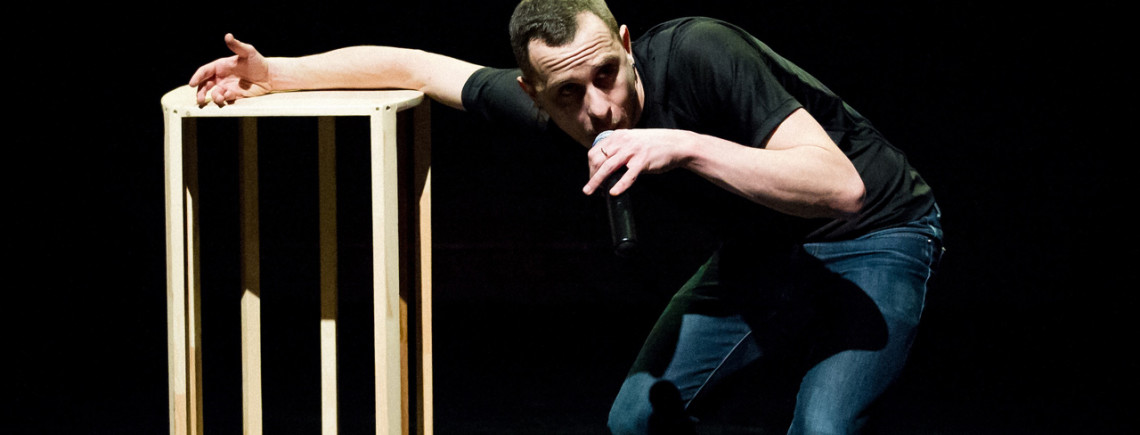
300 Words on Realness: Cult to the Built on What
300 Words on Realness: Cult to the Built on What
by Lydia Mokdessi
published on: January 17, 2014
Unique among shows I’ve seen at @R, Berlin-based Adam Linder’s Cult to the Built on What feels chaperoned; he is not just de facto emcee but it is prominent among his personas. The work begins in the hallway with a video, trimmed and looped like a series of GIFs. A ballet mistress encourages and instructs her virtuosic male student in a private lesson. The third person is revealed to be Linder. “Werk,” he chides, and slithers in his chair, snapping his spine and wrists. We smirk at the obvious incongruity of his behavior, but we’re not uncomfortable; we’re familiar with this type of cultural mixing. We enter while he “prepares the space” with whirling arms and fluttery feather duster hands.
He poses next to the lectern as if for a photo. He adopts the speech patterns and mannerisms I associate with my friend from Astoria. He spews rhythmic rap lyrics (“us being here puts this in an -ism,” “self-impressed gays with helvetica resumes”) in a variety of styles, from creepy overacting suave-ness to Nicki Minaj-esque rapidfire. He finds stillness and holds his hand limply to the side, preening and pivoting up the aisle as if trying to sell it to us. He slithers and self-strokes in a Vogue Fem approximation.
The lectern is his companion as he hauls it from spot to spot, finally placing it atop a small spinning platform and revealing it with shimmering purple disco light. This star treatment of a spartan piece of plywood hints at a disdain for the academy — or for unexamined privileging of a single, narrow culture over the sources of pantomimed swagger / new-agey energetics / urban micro-cultures that he is trying on.
After a year of PhD analyses of Miley Cyrus’s treatment of black bodies and uproar over Rihanna’s “burqa swag”, Cult feels topical. Linder is, at first glance, an unlikely candidate for “re-skilling” as a rapper, and yet he does — what other cultures can he inhabit? How many does he already inhabit? Isn’t ballet also a “culturally specific” dance form? Who is allowed to do and say what in front of whom? Cult to the Built on What doesn’t answer, but it approaches the conversation with sensitivity.
